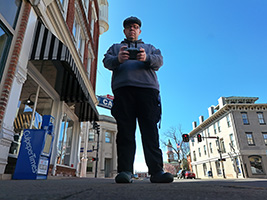An Urban Comparison
Introduction – Washington, DC – Richmond – Norfolk – Roanoke
Washington, DC
In the Washington DC area, I really hopped around a bit via Metro. Not only did I observe Washington DC itself, but I also viewed Alexandria, Virginia, as well as four of Arlington County’s six business districts – Crystal City, Rosslyn, Pentagon City, and Ballston. I skipped Courthouse and Virginia Square. Washington DC itself has been called America’s most European city, what with its layout, monuments, plus height restrictions on buildings. Some have referred to it as “The Paris of America”, and stating that it has a very European feel to it. Outside of Washington DC, in Arlington and Alexandria, the landscape is much more conventional, with no short supply on taller buildings.
Washington, DC
Outside the McPherson Square Metro station, we are immediately greeted by One Franklin Square, a postmodern building built in 1989.
In fact, much of this area consists of fairly recent construction, with postmodern and modern style designs.
The area is also very pedestrian-friendly, with wide, clear sidewalks.
Franklin Tower (One Franklin Square) is typical of buildings in this area – office buildings, with shops and such in front. In this case, flanking the entrance is Au Bon Pain and TD Waterhouse.
Alexandria, Virginia
In Alexandria, I was able to photograph from the observation deck of the George Washington Masonic National Memorial, affording an aerial view of the area. We saw some of this area in April 2002 with my Old Town Alexandria photo set. In fact, the road running down the middle of this photograph is King Street.
As best as I can tell, Alexandria is mostly low-rise, with taller buildings near Metro stations, as well as somewhat near the waterfront, and near National Airport, but not as high those in Arlington.
In the distance is Arlington. If you click on this picture to zoom in, you can get a fairly good view of Arlington’s Rosslyn neighborhood in the center of the picture, with another Arlington neighborhood to the left (anyone know which one this is?). This is a good example of how Arlington’s various business districts are situated, as little clusters of high-rise buildings. Note in the Rosslyn Neighborhood the Rosslyn Twin Towers, from the early 1980s, formerly the home of Gannett News. These two buildings are Arlington’s tallest.
One thing of interest to note is that Metro is able to operate above ground for almost its entire length in Alexandria, as seen here at the Eisenhower Avenue station seen here, and the Huntington station off in the distance.
Of course, the defining element of Alexandria’s skyline is the neoclassical-style George Washington Masonic Memorial atop Shooters Hill. However, this is not the tallest structure in Alexandria. That goes to the Hilton Alexandria Mark Center on Seminary Road.
Arlington, Virginia: Crystal City
The Crystal City neighborhood is mostly built in the modern style, meaning primarily squarish buildings with flat roofs, dating mostly from the late 1960s through the early 1980s. Here, built in 1968, is Crystal Mall 1 and 2.
Along with all the office towers in the area, there is residential space as well, with the Crystal Place buildings.
One thing that’s noteworthy about Crystal City is that below the streets is the Crystal City Underground, which is a network of tunnels that not only link the various office towers, but also contain shops and restaurants. The entrance to the Crystal City Metro station is also located in the Underground.
One feature of Crystal City is that in this area where I was photographing, the road is somewhat segregated from the pedestrian traffic, as the road dips down, but the sidewalks remain at “street level” as it was in the back of this picture, and there are bridges and such to make sure people can still get where they need to.
In the Crystal Square buildings, the only major exterior difference on the buildings is the windows. Crystal Square 3 (shown here) has the windows clustered together in groups, while Crystal Square 4 separates the windows individually and uses colored bands and such, and Crystal Square 5 is same as 4 without the bands.
A perfect example of modernism in the Crystal City neighborhood is Crystal Mall 3, seen here, part of the Crystal Plaza complex, built in 1967. Note the squared-off features and flat roof characteristic of Crystal City’s buildings, as well as the modern style in general.
Arlington, Virginia: Rosslyn
Rosslyn is the last on the line for Metro before the Blue and Orange lines head into Washington DC. Much of Rosslyn is done in the modern style, and has a lot of buildings from the 1970s and 1980s, with a few newer ones here and there. Pictured here is Rosslyn Center, built in 1980. The entrance to the Rosslyn Metro station is in this building.
This building, the Commonwealth Tower (formerly known as the Rosslyn-Commonwealth Building), built in 1971, was extensively renovated in the 1990s, with the addition of three floors and a completely new exterior curtain wall.
As you can see, Rosslyn has the modernist appearance of 1970s architecture…
One thing that we saw in Rosslyn that we had not seen so far was skywalks. Rosslyn does have a number of skywalks. The one in the picture above is part of Freedom Park, and housed the Journalists’ Memorial on it. There are other skywalks nearby as well. One leads from Rosslyn Center across North Fort Myer Drive, another leads from Rosslyn Center across North Moore Street to the Metro elevator, and then continues across North Lynn Street.
Now this is an interesting change! Beyond the AASA Building, we have 1801 North Lynn Street, Rosslyn’s newest high-rise. This building was completed in 2002, and is postmodern in design.
One notable building in Rosslyn is the Boeing Tower. Originally built in 1963, it was renovated in 1997 with the addition of more offices on the roof of the building. I consider the roof to be what makes the building distinctive in Rosslyn.
Arlington, Virginia: Pentagon City
The Pentagon City neighborhood seems to be the place where many people make their home, and the place to go to shop. Overall, the buildings here are more recent than the Rosslyn and Crystal City neighborhoods, with much of it dating from the 1980s.
As mentioned, Pentagon City is the place to go to shop. None more so than the space beneath and behind the postmodern Washington Tower, where the Fashion Centre at Pentagon City (Pentagon City Mall) is located. Additionally, there are a number of other large shopping facilities in the area.
A recent mixed-use development is Pentagon Row, behind Pentagon City Mall. Shops on bottom, apartments on top. Additionally, this center area plays host to many different things, including an ice rink during the winter.
Arlington, Virginia: Ballston
The Ballston neighborhood is about the same age as Pentagon City for the most part, but has a distinctly different character. To me, Ballston has the closest “feel” of Northwest DC in spots, but the buildings are taller. One nice find, though, that was comforting to see, was this traditional-looking church in the midst of the city.
As you can see, Ballston is busy well into the night, with lots of vehicular and pedestrian traffic going on, whereas Rosslyn and Crystal City are quiet by this time in the evening.
Another nice thing about Ballston is that the Ballston-MU Metro station has a canopy over it, with the Ballston Metro Center building right nearby, housing offices, restaurants, a hotel, and other services.
One thing about Ballston is that most of the buildings are distinctly postmodern in appearance. While you can’t see it here, the Qwest Building, shown here, is rounded on its upper floors, with a distinctly-shaped structure in its center. And note the shops at street level, shown here.
Ballston, like Pentagon City, has a lot of residential buildings, like this one, called Ballston Place.
To me, the thing that makes the postmodern style nice is the addition of simplified detail to the modern style. I really love the way this building breaks up an otherwise flat wall by adding these vertical window bands, also creating lovely picture windows for the residents of these apartments in the process.
One feature of Ballston is the Ballston Common Mall. Unlike Pentagon City Mall, there is no access directly from Metro, however, Metro passengers have a fully-covered route along the two blocks between the Metro and the mall via walkways and skywalks through Ballston Metro Center and Stafford Place.
And that’s Ballston, as viewed here from the skywalk between Ballston Metro Center and Stafford Place.











































